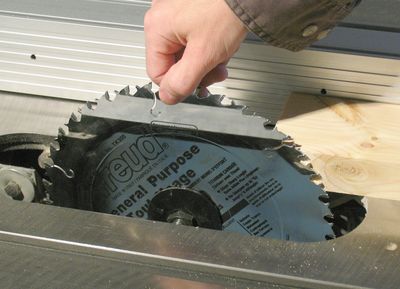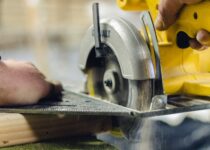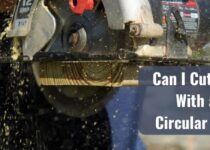Why Does My Circular Saw Blade Wobble
A wobbling circular saw blade is a common problem faced by many woodworkers. It can be caused by several factors, such as an improperly installed or worn out blade, worn bearings in the motor assembly, incorrect alignment of the arbor and flange, or a bent arbor. Not only does it reduce the accuracy of your cuts and cause excessive vibration, but it can also lead to dangerous kickback from the saw.
Identifying and fixing the causes of this problem is essential to preventing damage to your workpiece or yourself while working with power tools.
The first step in diagnosing why your circular saw blade may be wobbling is to examine the installation of your blade onto its arbor and flange. Make sure that all screws are securely fastened without any gaps between them; if there’s any looseness here then you should tighten them up before continuing further troubleshooting steps.
Additionally, check for debris around these parts that could prevent proper contact between them; remove such material using compressed air (if available) or a soft cloth damped with mineral spirits if necessary.
If you’ve been using a circular saw for any length of time, you know that one of the most common issues is blade wobble. Blade wobble can be dangerous and cause damage to your project if not addressed quickly. In this blog post, we’ll discuss why your circular saw blade might be wobbling and how to fix it.
The most common reason why a circular saw blade might start to wobble is because the arbor (the shaft which holds the blade in place) has become bent or damaged. If this is the case with yours, you will need to replace it as soon as possible before continuing with your work. Another possible cause could be that there’s too much play in between your motor bearings – meaning they are allowing more movement than usual when spinning up the blades rotation speed.
This can also lead to an unbalanced cutting action and should also be checked out by replacing them with new ones if necessary. Another potential culprit behind a wobbly saw blade is an uneven tension on the arbor nut or bolt which holds it in place on the saw body itself. Over-tightening can make things worse so always check for an even tension across all sides when tightening up components like these on power tools – especially those involving rotating parts!
Finally, debris such as dust or wood chips can get caught inside of the holes where blades attach onto their respective motors/saws leading to imbalance during operation due its additional weight being added from these particles getting stuck somewhere along its surface area/axis point(s). To prevent this from happening regularly try vacuuming out any air intakes located near each end of both machines while they’re off & cooled down (if applicable) after every use session just so nothing remains lodged inside causing further problems later down line! In conclusion, if your circular saw blade starts to wobble then check for bent or damaged arbors, faulty motor bearings and loose tensioning screws before taking further action such as replacing parts or calling a professional repairman for help!
How to Tighten Circular Saw Blade
If you’ve ever used a circular saw, then you know that keeping the blade tight is absolutely essential to get the best performance and accuracy out of your tool. Loose blades can cause kickback or ruin whatever material you are cutting, so it’s important to check periodically and make sure it’s secure. Tightening a circular saw blade isn’t difficult, but it does require some specific steps for proper security.
Here’s how to do it:
1. Start by unplugging the power cord from the outlet before attempting any maintenance on your saw. This will ensure that no one accidentally turns on the saw while you’re working on it.
2. Next, remove any debris from around the arbor nut – which holds in place at center of your circular saw blade – with a brush or cloth rag so that you have plenty of room to work with when removing and replacing parts later on down the line.
3. Take out two wrenches (one adjustable wrench and one regular) and use them together in order to loosen up both sides of arbor nut until they come apart easily without too much force applied; be careful not to over tighten as this could damage other components inside your circular saw motor housing unit or even strip off threads completely!
4. Once loose enough, take off one side (either left-hand threading or right-hand threading depending on type) using only hands now instead since there should not be too much resistance anymore due lack pressure applied earlier via wrenches/pliers etcetera…now inspect condition inside exposed area as well as outside surface area near where arbor was located just prior removal process began; replace if necessary with same size part per manufacturer instructions & torque specifications listed in user manual provided upon purchase date time frame .
5 Lastly , reassemble all pieces back into place including screwdriver attachment (if present), making sure everything fits snugly but never over tightening anything again ! Now your Circular Saw Blade is tightened properly & ready for use once more safely !

Credit: www.woodgears.ca
What Causes Blade Wobble?
Blade wobble is an issue that can occur in any type of machine with a rotating blade, such as circular saws, miter saws and table saws. It is caused by either a mechanical problem or an imbalance in the blade itself.
Mechanical problems are one of the leading causes of blade wobble.
If there is something wrong with the motor or drive system, it can cause vibration which will lead to blades shaking and potentially bending during operation. Additionally, if the bearings that support the motor shaft are worn out or not functioning correctly, it will also cause instability in the movement of the blade resulting in wobbling.
In addition to mechanical issues, imbalanced blades can trigger wobbling too.
Blades come pre-balanced from their manufacturer but over time they may become out of balance due to wear and tear from use as well as environmental factors like temperature changes causing them to expand/contract differently on each side than when originally balanced by its manufacturer. The result would be an unbalanced weight distribution along its length which could lead to vibrations and eventually create blade wobble during operation.
Finally another potential cause for this issue would be loose mounting bolts connecting your blades’ arbor flange (the part that attaches your blade onto your saw) to your motor shaft; if these bolts aren’t secured tight enough then they won’t provide sufficient stability between those two components creating vibrations throughout both parts thus producing more pronounced types of wobbles while operating your machine tools .
In order to diagnose what might be causing this problem you should first check whether any mechanical issues exist within your machines powertrain or drive mechanism before moving onto assessing whether or not you have any imbalances present among all areas connected directly above & below where your blades attach themselves on their respective arbors/spindles etc…
How Do You Balance a Circular Saw Blade?
Achieving the perfect balance on a circular saw blade is essential for getting great results from your work. A balanced saw blade will move more smoothly and efficiently, giving you a better finish and reducing vibration. It’s important to take the time to properly balance your blades every now and then in order to ensure that they are performing at their best.
The first step in balancing a circular saw blade is to inspect it for any signs of damage or wear. If the teeth appear worn down or chipped, then it’s time for a replacement blade instead of trying to balance it out. If all looks good, however, then you can begin balancing the saw with some simple tools: an adjustable square block and a feeler gauge.
Start by clamping the adjustable square block onto one side of the saw blade near its center point so that one edge is flush against its surface while leaving enough room between them that they don’t touch each other when moved back and forth slightly (this will help keep track of where adjustments need to be made). Next use your feeler gauge along both sides of the square block; if either side has greater resistance than usual when you slide it through, make sure you mark which side needs adjustment before continuing on with steps 3-5 below:
3) Mark off two points – one each directly opposite from each other on either side of the center point – using permanent markers or chalk as reference points for adjusting tension later on during this process; these should also be labeled according to which direction (left/right) needs tension added/released accordingly
4) Place another adjustable square block onto one side of those marked reference points while ensuring that they’re still separated without touching; again check with your feeler gauge here too if necessary
5) Adjust tension by loosening/tightening screws evenly across both sides until there’s no longer any difference in resistance when sliding through with your feeler gauge Finally recheck everything once more before finishing up this task!
If done correctly, you should have achieved perfect balance from end-to-end across all surfaces touched by your tools – congratulations!
Why is My Circular Saw Vibrating?
If you’ve been using a circular saw and noticed that it’s started to vibrate, there are several potential causes. This can range from something as simple as needing to change the blade of the saw all the way up to needing major repairs. In this blog post, we’ll discuss some of the common reasons why your circular saw might be vibrating and how you can fix them.
One possible cause is a dull or damaged blade. If your blade is no longer cutting cleanly or has become chipped or cracked, it can begin to vibrate more than normal when in use. You should replace any blades that are damaged so that they don’t cause further damage to your tool or other materials you’re working with.
Additionally, if your blade has become dull over time then sharpening it will help reduce vibration when in use again. Another possible reason for vibration could be an issue with motor alignment on the circular saw itself. If something inside the motor housing isn’t lined up properly, this can create friction which causes vibrations during operation.
The best way to check for misalignment is by taking off the guard plate around where you insert blades into the saw and looking inside at where these components meet together – look specifically for gaps between parts that don’t line up correctly and make sure everything fits flush together without movement before continuing work on your project! Finally, another potential cause of vibrations coming from a circular saw may be due to worn-out bearings in its handle assembly.
This part helps keep things moving smoothly but if they wear out over time due excessive usage (or lack thereof!) , then vibrations from within will start occurring when operating again – usually accompanied by loud noises too! To fix this problem requires replacing both handles assemblies which should restore normal functioning levels back once completed successfully In conclusion, there are several potential causes behind why your circular saw may be vibrating while in use – ranging from a dull/damaged blade all the way through to issues with its internal motor alignment or even worn-out bearing assemblies found within its handle set-up!
No matter what though remember: always take appropriate safety precautions while working with tools like these before attempting any fixes yourself; otherwise you risk serious injury if not handled correctly!
How Do I Align Correctly With Circular Saw?
Working with a circular saw is an essential skill for any DIYer. While it may seem intimidating at first, aligning a circular saw correctly isn’t too difficult. With a few quick steps, you can ensure that your cuts are smooth and accurate every time.
When setting up to make a cut, the most important factor is ensuring that the blade of the saw is perfectly aligned with the cutting line. First, use a square or straight edge to draw your cut line on whatever material you’re working with – whether it’s wood, plastic or metal. This will help you keep track of where your saw should be when making its pass through the material.
Next, adjust the depth of your blade so that it won’t penetrate further than necessary while still leaving enough room for cleanly cutting through all layers of material below it (if applicable). To do this, loosen and raise or lower the blade guard until it’s in line with what you want before locking everything down securely again.
Now comes time to actually align your circular saw properly against your cut line.
Begin by positioning one side of the footplate flat against outside edge next to where you need to make a cut – but don’t press down yet! Instead take some time adjusting both back-and-forth as well as side-to-side positions until you know for sure that everything lines up correctly according to where draw earlier on in step one; once that has been achieved then fixate both positions into place by tightening their respective screws/clamps/stops accordingly before continuing onwards from thereon outwards towards step four: make sure not move any part(s) away from its locked position whilst doing so!
Furthermore verify if needed via measuring tape if distances between edges remain constant throughout entire process or else re-align them appropriately by loosening/tightening corresponding screws accordingly until they match desired distance requirements before beginning work itself – only then proceed onto using actual machine itself during actual operation phase; always double check afterwards afterwards either visually via eye sight verification alongside ruler+measuring tape combo just in case something went wrong unexpectedly along way which can happen due unforeseen circumstances such as incorrect measurements taken beforehand etcetera… et cetera…
Finally – after ensuring accuracy in alignment – press down firmly on top plate and start slicing away at materials being worked upon!
Causes for Blade Wobble
Conclusion
If you’re using a circular saw and noticing that the blade is wobbling, it could be due to several reasons. The most common causes are either an unbalanced or dull blade, improper installation of the blade in the saw, or damage to the arbor shaft. To fix this issue, first check if your blade is sharp and balanced—it should spin without any vibration when held off the ground.
If not, replace it with a new one. Next make sure that your blade has been properly installed on the arbor shaft as per manufacturer’s instructions – such as tightening down all screws equally until they bottom out against their respective flat surfaces. Lastly inspect for any signs of damage on your arbor shaft which may need to be replaced if necessary.
Following these steps should help reduce any wobble in your saw blades while allowing you to work safely and efficiently!


